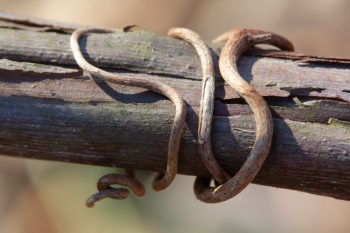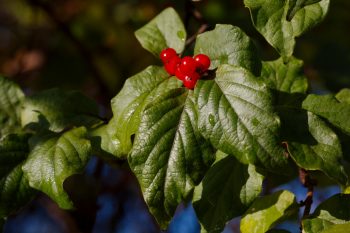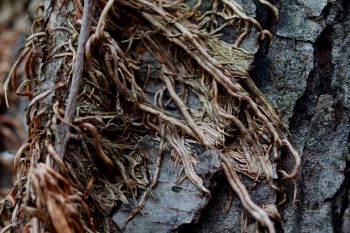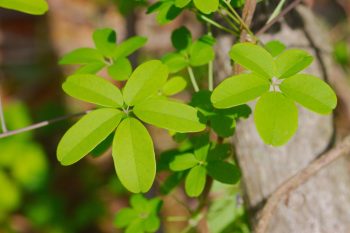This is actually more ring size, the branch is about a half inch in diameter, but in this picture it looks like a bracelet, I think. I imagine it worked in silver.
Tagged With: Vine
Lonicera maackii (Amur Honeysuckle)
This is one of the more prevalent weed shrubs in our area. The Amur honeysuckle (Lonicera maackii) is an east Asian native that has firmly established itself as noxious weed in the eastern half of North America. It’s got the sweet, tubular flowers typical to honeysuckles, starting out white and aging to yellow. They are followed in the fall (right about now, obviously) by bright red, juicy berries. Although they are inedible to humans, birds eat them and spread the seeds far and wide. They were once planted as an ornamental and you can see why. However, they are no longer recommended, because of their invasive nature.
Ivy Roots
There are places where English ivy (Hedera helix) looks really nice. It’s also a very good ground cover for many situations. Nevertheless, I’m not a huge fan. In a city, where it can perhaps be contained reasonably well by paving, etc., it’s suitable. In the suburbs and rural areas it can really be an annoyance. This ivy is growing up a tree near my office and you can see how it grips its host. It will grow up into the tallest trees and eventually strangle them. It also covers the ground so completely that in often chokes out less aggressive plants (and there are only a few more aggressive). We’ve done our best to eliminate it from our yard and with a small patch that seems to reappear occasionally, we’ve succeeded. But we remain on DEFCON 3 or higher.
White Flowering Clematis
In the back of our garden, near the fence where there was a huge rose bush, there is a clematis. For years it’s struggled to be seen among the rose, which was often out of control. Well, the rose is gone now, having mysteriously died last year. I’m sad about that, and wish it hadn’t died but at least this beautiful, white clematis is still there and is doing quite well, now that it’s getting the sun it needs and isn’t overshadowed by the huge plant. We will need something for it to clime on but for now, it’s just happy to be blooming in the sun.
Akebia quinata
Years ago my dad planted both three- and five-leaved akebia at the land in Pennsylvania. I haven’t found any of the three-leaved type but there is some five-leaved Akebia quinata, also known as chocolate vine. Although it is listed as a noxious weed in some states, and while it’s managed to survive without any care here, it hasn’t spread in a way that’s concerning, especially when compared to the hardy kiwi that’s nearby. I love the leaves, as shown here. It has interesting, purple flowers and one of the more unique fruits I’ve seen. From the Missouri Botanic Garden’s Plant Finder, “Flowers give way to sausage-shaped, violet fruit pods (to 4” long) which split open in fall to reveal small black seeds imbedded in a whitish pulp. The whitish pulp is edible.”





